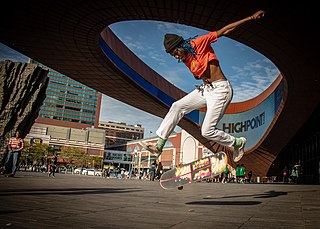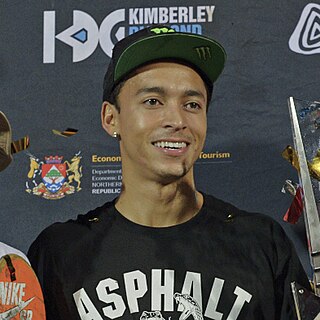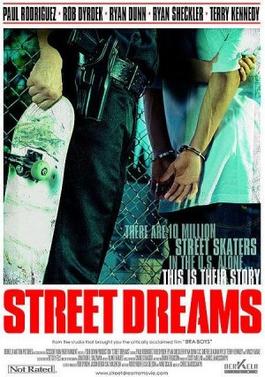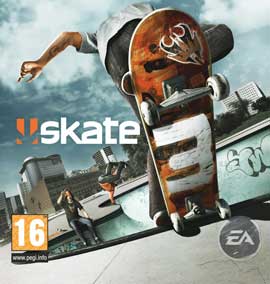Related Research Articles

Skateboarding is an action sport that involves riding and performing tricks using a skateboard, as well as a recreational activity, an art form, an entertainment industry job, and a method of transportation. Originating in the United States, skateboarding has been shaped and influenced by many skateboarders throughout the years. A 2009 report found that the skateboarding market is worth an estimated $4.8 billion in annual revenue, with 11.08 million active skateboarders in the world. In 2016, it was announced that skateboarding would be represented at the 2020 Summer Olympics in Tokyo, for both male and female teams.

A skatepark, or skate park, is a purpose-built recreational environment made for skateboarding, BMX, scootering, and aggressive inline skating. A skatepark may contain half-pipes, handrails, funboxes, vert ramps, stairsets, quarter pipes, ledges, spine transfers, pyramids, banked ramps, full pipes, pools, bowls, snake runs, and any number of other objects.

A half-pipe is a structure used in gravity extreme sports such as snowboarding, skateboarding, skiing, freestyle BMX, skating, and scooter riding.

Longboarding is a variation of skateboarding typified by the use of longer boards ("decks") with longer wheelbases and softer wheels. While longboards vary widely in shape and size, compared to street skateboards longboards are designed to be more stable at speed and to have more traction due to larger wheel sizes and softer wheel durometers. While standard street skateboards may typically be between 28 and 34 inches long, longboards can range anywhere from 32 to 50 inches in length. Ride characteristics of longboards generally differ from that of street skateboards due to the use of specialized longboard trucks that have different properties than those typically used with skateboards; while street skateboards use "traditional kingpin" (TKP) trucks that are optimized for tight turning radii, ollie and flip tricks, slides, grinds, and transition skating, longboards are typically paired with "reverse kingpin" (RKP) trucks that are designed for increased stability at higher speeds, more "surfy" carving characteristics, and/or greater ride comfort for commuting over longer distances.

Enjoi is a skateboarding company that specialises in producing skateboard decks as the brand's primary product; the company also manufactures skateboarding accessories and clothing. The company distributed by Dwindle Distribution, has since been known for its humorous and satirical designs and has adopted a stylised panda as its logo. Enjoi was founded in 2000 by Marc Johnson and Rodney Mullen. Their headquarters is situated in Los Angeles, California.

Chad Muska is an American professional skateboarder, musician and entrepreneur. In November 2012, Skin Phillips, editor-in-chief of Transworld Skateboarding, described Muska as "one of the most marketable pros skateboarding has ever seen."

Video Days is a skateboarding video by Blind Skateboards released in 1991, which is often credited as the most important skate video of all time.

James Chris Cole is an American professional skateboarder. As of September 2020, his sponsors are Fallen Footwear, Monster Energy, Bones Bearings, Cult Crew, Thunder Trucks, Spitfire Wheels, Stance, Kershaw Knives, Grizzly Griptape, GoPro, Indian Motorcycles, cbdMD, Remind Insoles, and most recently Zero Skateboards.

A slide is a skateboarding trick where the skateboarder slides sideways either on the deck or the trucks.

Nyjah Imani Huston is an American professional skateboarder. With numerous sponsorships and competition prize winnings, Huston is one of the highest paid skateboarders in the world. Huston won gold medals at the SLS Super Crown World Championship in 2014, 2017 to 2019, and has won 12 gold medals at the X Games since 2011.

The Wallenberg Set, also known as the Wallenberg Four or simply Wallenberg, is a popular location in the skateboarding community. Located at the Raoul Wallenberg Traditional High School in San Francisco, California, it consists of four tiers of pavement and curbing, adjacent to a stairway and next to a parking area. The section notable for skateboarding measures 4 feet 4.8 inches (1.341 m) in height and 16 feet 6 inches (5.03 m) in length.

Hubba Hideout was one of the most famous skateboarding spots. It was located in San Francisco near the Justin Herman Plaza on The Embarcadero. Its central features were two oversized sets of 6 stairs with large concrete ledges on both sides. The spot is part of a pedestrian walkway but was more commonly used by the local skateboarders and vagrants. The city of San Francisco made numerous attempts over the years to ward off skateboarders from the spot, and in January 2011 city workers completely demolished its ledges and stairs.

Skate is a 2007 skateboarding video game for Xbox 360, PlayStation 3 and mobile phones. It was developed by EA Black Box. Two sequels, Skate 2 and Skate 3, have been released for PlayStation 3 and Xbox 360, as well as Skate It, a spin-off for Wii, Nintendo DS and iOS platforms. In 2020, EA announced plans for a new Skate game. It received positive reviews from critics.

Skate 2 is a skateboarding video game developed by EA Black Box and published by Electronic Arts. The game was released worldwide in January 2009 for PlayStation 3 and Xbox 360 after the spin-off title Skate It. It is the sequel to 2007's Skate and the third installment in the Skate series overall.

A mega ramp, or megaramp, is a large vert ramp structure, often used in skateboarding and freestyle BMX. First built in the 1990s and 2000s, megaramps are twice or more the size of earlier vert ramps.

Street Dreams is a 2009 American film directed by Chris Zamoscianyk, produced by Rob Dyrdek, Jason Bergh and Sal Masekela and written by Elisa Delson, Rob Dyrdek, and Nino Scalia.

Skate 3 is a skateboarding video game, the third installment in the Skate series and the sequel to 2009's Skate 2, developed by EA Black Box and published by Electronic Arts. It was released worldwide in May 2010 for PlayStation 3 and Xbox 360. The game takes place in the fictional city of Port Carverton, which embraces skateboarding, unlike considering it a crime in the second game. The player character goes by the alias "The Legend". After failing to "Jump The Shark", their goal becomes creating a successful skateboarding team. It is the player's goal to sell one million boards by completing challenges. The game introduced some new features including new tricks, a park builder, and "Easy" and "Hardcore" modes instead of just "Normal" mode.

Street skateboarding is a skateboarding discipline which focuses on flat-ground tricks, grinds, slides and aerials within urban environments, and public spaces. Street skateboarders meet, skate, and hang out in and around urban areas referred to as "spots," which are commonly streets, plazas or industrial areas. To add variety and complexity to street skateboarding, obstacles such as handrails, stairs, walls, flower beds, bins, park benches, picnic tables, and other street furniture may be traversed as single tricks or as part of a series of consecutive tricks called a "line."
"The Buszy", built in 2005, is a skatepark plaza in Milton Keynes, England. The skate area is covered almost entirely by the roof of the former Milton Keynes Central bus station.